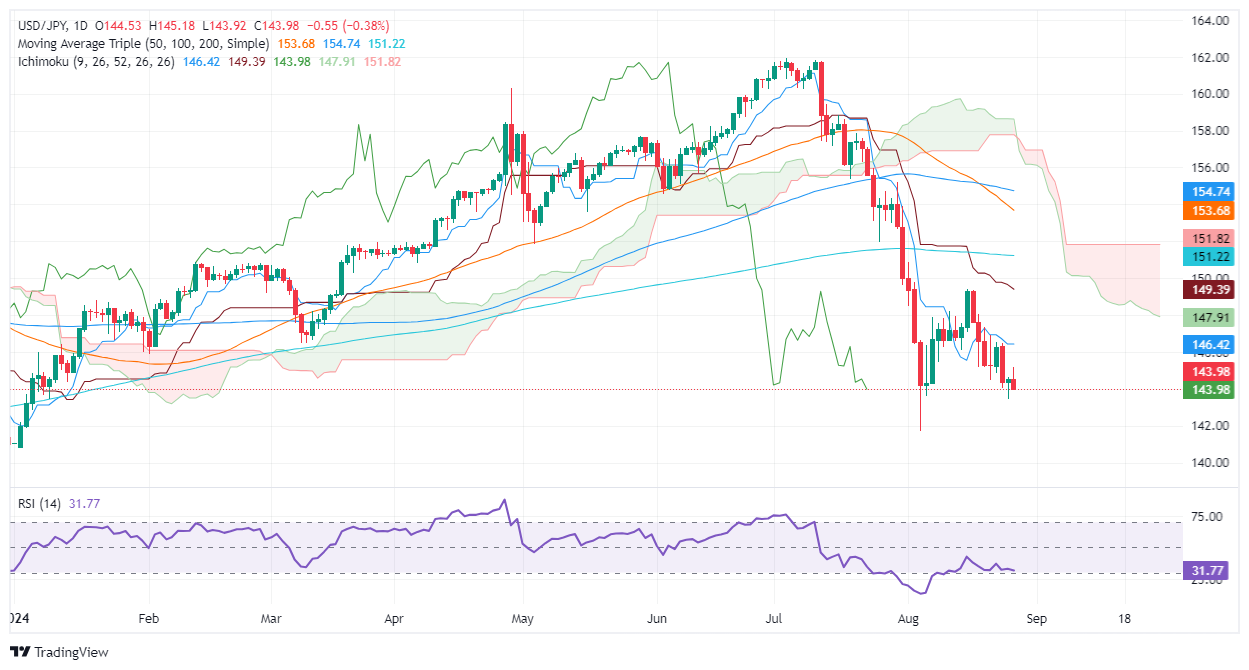- USD/JPY retreats from 145.00, pressured by falling US Treasury yields and a weaker Dollar.
- Bearish trend outlook; momentum favors sellers with RSI remaining negative.
- Key Supports: August 26 low at 143.44, then 143.00, 142.00 and August 5 low at 141.69.
- Upside: Break above 144.00 targets resistance at 146.42 (Tenkan-Sen) and potentially 147.00.
The USD/JPY retreats from the 145.00 area and falls below the 144.00 figure as US Treasury bond yields decline. The Dollar extends its losses, as seen in the US Dollar Index (DXY), which tracks a basket of six currencies against the Greenback. It fell 0.31% to 100.54. At the time of writing, the pair is trading at 143.94, down 0.40%.
USD/JPY Price Forecast: Technical Outlook
USD/JPY continues to trade “relatively sideways,” with sellers stepping in ahead of the release of crucial US inflation data on Friday. Nevertheless, from a technical standpoint, the pair will retest the August 5 daily low of 141.69 if traders overcome a few hurdles on the way south.
At the time of writing, momentum is in favor of sellers, as shown by the Relative Strength Index (RSI), which remains bearish. That said, the first level of support for the USD/JPY would be the August 26 low of 143.44. Once overcome, the next stop would be the psychological figure of 143.00, followed by the figure of 142.00, before challenging the aforementioned August 5 cycle low.
On the contrary, if the USD/JPY breaks above the 144.00 figure, the pair could head higher and challenge higher prices. The next resistance would be the Tenkan-Sen at 146.42, followed by the 147.00 level.
USD/JPY Price Action – Daily Chart
Japanese Yen FAQs
The Japanese Yen (JPY) is one of the most traded currencies in the world. Its value is determined broadly by the performance of the Japanese economy, but more specifically by the policy of the Bank of Japan, the spread between Japanese and US bond yields, and risk sentiment among traders, among other factors.
One of the Bank of Japan’s mandates is currency control, so its moves are key to the Yen. The BoJ has intervened directly in currency markets on occasion, usually to lower the value of the Yen, although it often refrains from doing so due to political concerns of its major trading partners. The BoJ’s current ultra-loose monetary policy, based on massive stimulus to the economy, has caused the Yen to depreciate against its major currency peers. This process has been exacerbated more recently by a growing policy divergence between the BoJ and other major central banks, which have opted to sharply raise interest rates to combat decades-old levels of inflation.
The Bank of Japan’s stance of maintaining an ultra-loose monetary policy has led to an increase in policy divergence with other central banks, in particular with the US Federal Reserve. This favours the widening of the spread between US and Japanese 10-year bonds, which favours the Dollar against the Yen.
The Japanese Yen is often considered a safe haven investment. This means that in times of market stress, investors are more likely to put their money into the Japanese currency due to its perceived reliability and stability. In turbulent times, the Yen is likely to appreciate against other currencies that are considered riskier to invest in.
Source: Fx Street
I am Joshua Winder, a senior-level journalist and editor at World Stock Market. I specialize in covering news related to the stock market and economic trends. With more than 8 years of experience in this field, I have become an expert in financial reporting.








